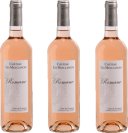Pirramimma White Label Old Bush Vine Grenache
The premium fruit parcels used to produce this stunning Old Bush Vine Grenache were handpicked from the company owned Katunga block and Prisoner of War vineyard. These grapes were then crushed and fermented in open concrete vats, followed by daily pump over. The juice obtained after primary fermentation was drained and basket pressed. Post-maturation in American oak barriques, this beautiful Grenache flaunts a bright purple hue with a crimson haze. The perfumed nose exudes elegant aromas of cherries, chocolate, spice and rose petal. A sip of the wine presents enticing flavours of black plum, sweet, spicy raspberry, fruitcake and toffee apple. These beautiful characters are balanced by subtle savoury oak notes, ending the wine in a captivating finish. It tastes excellent with veal kidneys, grilled bratwurst and young Gouda cheese.
Rameau d'Or Rose
Domaine de La Croix Provence Rosé
Located on the peninsula of Saint-Tropez, Domaine de La Croix vineyards face the sea and enjoy optimal conditions for producing fresh and elegant wines. Full of finesse, this wine has lovely fruity notes of citrus, wild peaches and red berries. Long, fresh and round finish, perfect as an aperitif or to pair with grilled fish or prawns, roast meat and stuffed or grilled vegetables.
Minuty Prestige Rosé
Hecht & Bannier Cotes de Provence Rose
a Provence rose of immense charm and minerality redolent of fennel, anise and purple flowers.
Caves D’Esclans Whispering Angel Rosé
Chateau d’Esclans is situated in the heart of Provence, northeast of St. Tropez. With his acquisition of the Château in 2006, Sacha Lichine’s vision was to create the greatest rosés in the world, igniting the “Rosé Renaissance”. Château d’Esclans is home to Whispering Angel which is made from grapes sourced from amongst the most choice Vineyards in the vicinity of the Esclans Valley and nearby in the Cotes de Provence region. Harvesting is only conducted during at night time to avoid the heat of the day & to keep the crop of grapes fresh. Upon arriving in the Cellars, grapes are sorted for both health and quality ensuring that the selected grapes are assessed accurately in terms of overall quality. The harvest takes place each September, where grapes, at their ripest, are selected, picked and carefully placed in small crates, chosen in order to avoid too many grapes at the top crushing grapes at the bottom. Once the grapes arrive to the cellars all grapes which go into vinification are de-stemmed and resemble each of the physical characteristics dictated by the wine maker including shape, size, colour and condition. This is verified by an optical eye camera which is programmed to detect whether grapes correspond to the established criteria. The grapes are then sent through a soft crush mechanism which punctures them in order for the juice inside to flow followed by their entering a heat exchange system which reduces their temperature from what can be as high as 29 degrees celsius down to 7-8 degrees. Temperature reduction ensures that freshness and vivacity are locked in which is key to ensure consistent temperature control making the grapes ready for closed circuit (nitrogen) pressing ensues which produces 3 grades of what is primarily free run juice. Nitrogen pressing ensures no oxidation is taking place during the pressing process known as an accumulation of details that is carefully planned and monitored. Depending on which grade of juice the press produces, the wine makers determine which will be used to make barrel fermented (aged) wine or stainless steel fermented wine. The different grades of juice differ in terms of skin contact which pertains exclusively to the first press while the next two have no skin contact and increase in intensity from one to the next. The overall affect is a clear, clean tannin free juice which gives the wines an agreeable characteristic and taste profile while ensuring that the colour is quite pale. As the individual juices from corresponding Barrels and Vats are selected and placed into half bottles, the technical team will taste through these unique juices and they will start to form opinions for which wines they should be used to make the new vintage. The information which comes from this step in the process is noted for referential purposes related to the next step, the assemblage. The last step is the assemblage or blending for Chateau d’Esclans and Caves d’Esclans wines. While there is little variation vintage to vintage, percentage of different grape varieties that will make up the ultimate blend will differ with each new vintage, however the taste profile remains the same. Made from Grenache, Cinsault and Rolle (Vermentino) grapes, its pale colour is pleasing to the eye and draws one in. The rewarding taste profile is full and lush while being bone dry with a smooth finish. A blend of the best free run juices and press juices, fermented and aged in stainless steel with temperature control. A beautifully pale pink, which is pleasing to the eye and draws one in. Flavours of fresh red berry fruit characteristics with floral notes and a ripe and fleshy feel on the palate. This popular rosé wine has great concentration, a smooth and round finish and no astringent aftertaste.
Château de Saint-Martin Cru Classé Provence Rosé
Colour: Pale with bluish reflections. Nose: Sweet and acidulated boiled sweets (hard candy) with very pretty fruit notes. Palate: Nice balance between the nose and the mouth. Floral notes with a blood orange finish. Recommendations: Mediterranean cuisine: appetizers, mixed salads, grilled meats, asian and summer dishes.
Les Mesclances Romane Rosé
An outstanding Cotes de Provence, very elegant, structured and aromatic - the best companion for warm summer nights. On the nose, it smells of fruit, English sweets and redcurrants. On the palate it is fresh and subtle. Overall, it is a structured and aromatic wine best enjoyed as an apertif due to its freshness.













